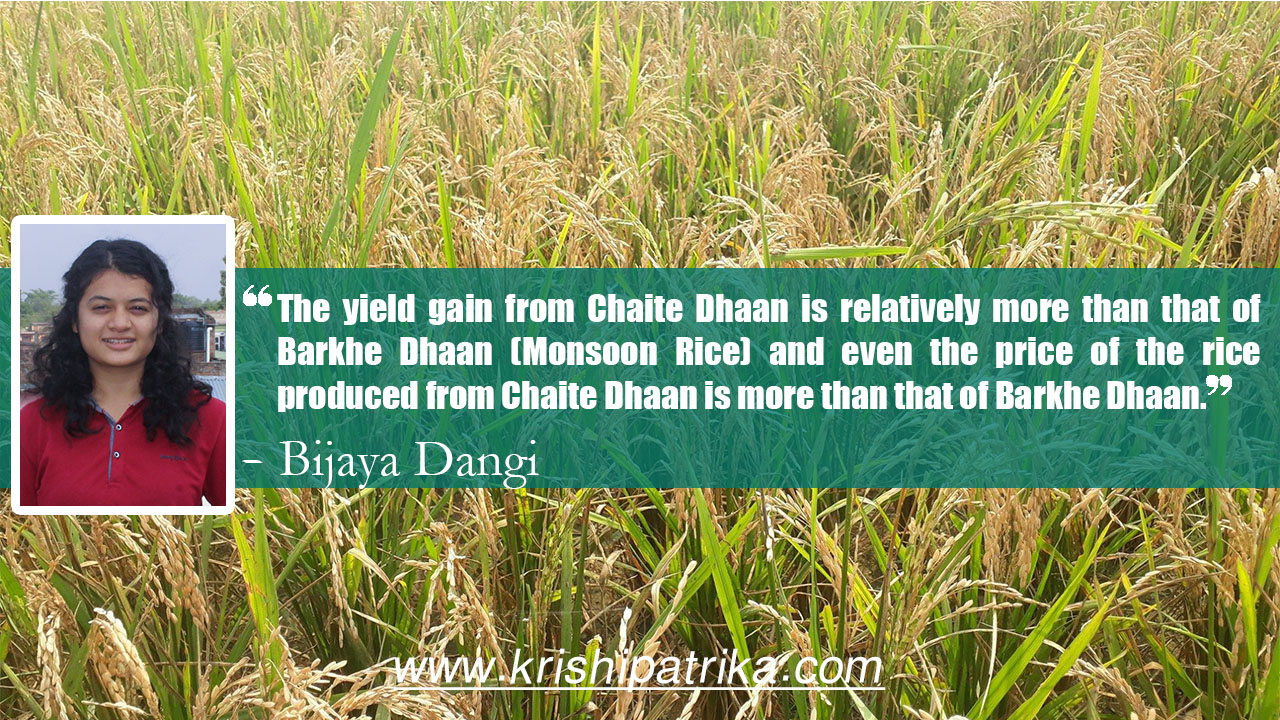
Rice is the staple food of Nepal by far but still, the production of rice in our country is not able to keep up with the increasing population. Rice production is an inseparable part of our cropping system. It is cultivated in every part of our country. According to NARC, rice accounts for about 50 percent of the total agricultural area and production in the country and it is grown on about 1.45 million hectares of land. Among the total rice cultivation area, 92% falls under the main season rice cultivation area while about 7% falls under the spring rice.
Main season rice (monsoon rice) is something that we all know about. But chaite dhaan is the one which we should not forget about and captivate our interests into. The month of the transplantation of this rice is the Nepali month, Chaitra, so it got its name as Chaite Dhaan. It is also called ‘Hiunde Dhaan’ as it is sowed in winter. According to the latest data, Chaite Dhaan is produced only on 112,000 hectares of land in Nepal. It is mainly cultivated in the central and eastern Terai and mid-hill regions of Nepal. In Nepal, the Chitwan district is most popular for spring rice cultivation. Chaite Dhaan is considered the second most important crop in Chitwan. CH-45, Chaite-2, Chaite-4, Chaite-6, Hardinath-I, and Bindeshwari are some of the varieties of rice planted during spring. Around 11 varieties of spring paddy have been released for the terai, inner terai, and river basin areas so far. These are all short-duration varieties and have large grain rice. Variety CH-45 is a popular spring rice variety in Terai, but it has been partly replaced by Chaite-2 and Chaite-4. Bindeshwari is grown in rainfed lowland during the monsoon, though it was released for the spring season. The seedling, in the nursery bed, for the Chaite dhaan is done during Falgun(February – March) and transplanting is done during Chaitra (March- April). Then the rice plant becomes ready for harvest during Ashad (June – July). Seedlings require a 30-40 days duration to be ready for transplanting. More than 50% of the farmers around Rampur, Arun river, Purba River, Jhadewa, Nisidi River, Argali, and Lamdi River used to cultivate Chaite Dhaan so that the water requirement of the paddy could be fulfilled with ease.
The yield gain from Chaite Dhaan is relatively more than that of Barkhe Dhaan (Monsoon Rice) and even the price of the rice produced from Chaite Dhaan is more than that of Barkhe Dhaan. Chaite Dhaan is preferred for making chiura (beaten rice) as its grains are larger. Spring paddy is even relatively more resistant to diseases and pests, which results in a lesser quantity of loss percentage during production. According to the various researches done, the productivity of spring paddy is 4 tons per hectare whereas the productivity of main season rice is only 3.17 tons.
Despite all those plus points, the production of the Chaite Dhaan is decreasing. There are various reasons for the dropping production rate of spring rice: Chaite Dhaan is not everyone’s first choice for consumption as they bear large grain. Everyone wants smooth, fine, long-grain rice. Also, the migration of people towards urban areas leaving their fields barren in the villages has decreased the production rate. The attraction of young manpower towards foreign countries has left the villages with old people, women and children only, who are also willing to buy rice with the remittance sent than to cultivate chaite dhaan. Spring, the season itself is the cause of less production, in this time of the year there is no rainfall usually, and without proper irrigation cultivation of Chaite Dhaan is quite difficult. In many parts of our country, there is no proper irrigation facility which is the major drawback. And the places having all the requirements for successful rice cultivation like irrigation, soil fertility, high yielding varieties, land management, and access to various technologies and types of machinery there is still low production of the rice. Because the farmers are still practicing the old traditional method for cultivation. They have not been able to keep up with the spring rice cultivation techniques.
The Government is also putting efforts into the betterment of spring rice cultivation and conducting different researches. Such research was also conducted in Chitwan. In 2016, the government even came up with schemes of expanding the acreage of spring paddy by 200,000 hectares only for the increment in the output of the spring rice and make the country a step forward on the path of self-reliance on food. The Ministry of Agricultural Development has also shown its attention in boosting the production of both summer and spring crops; in which Chaite Dhaan falls.
If only the government provides the proper irrigation facility in those regions, where this rice could be cultivated then Chaite Dhaan would definitely assist the country’s agricultural status. Priority to the spring rice can be of great aid to the short supply of cereal of the country. If we could make the spring rice as popular as the monsoon rice and convince and encourage people to cultivate spring rice and consume it, we could be independent in the rice cultivation, no more import of rice would be there. The saved currency of the country could be used in the modernization of agriculture.
Therefore, Chaite Dhaan could be proved as the turning point in the country’s agriculture if it could be prioritized and cultivated throughout the country on a large scale.









